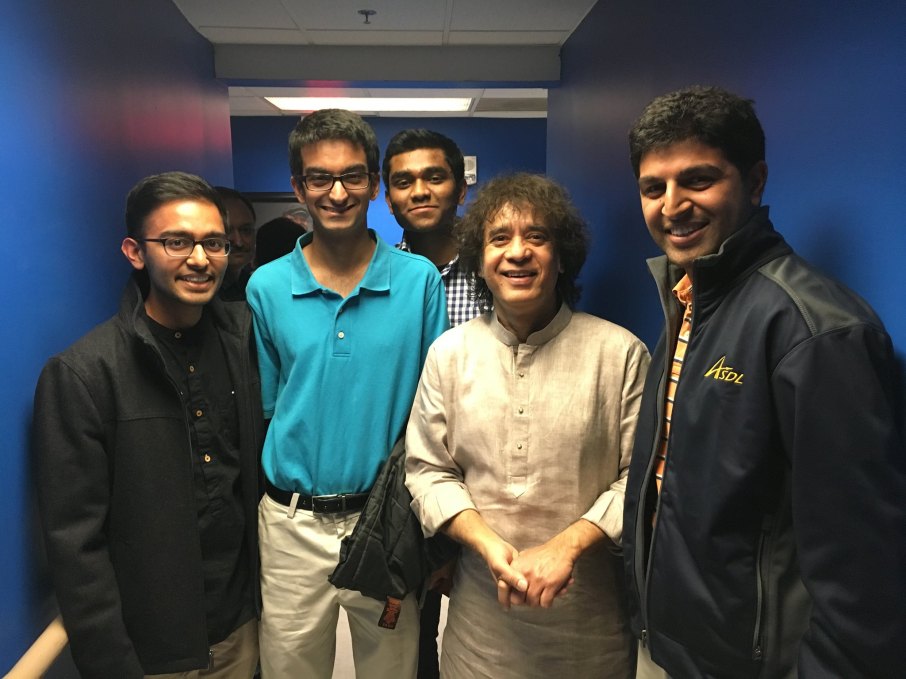The Universality of Music: Exploring Indian Classical Tradition
Guest Post written by: Saurabh Kumar
The Concert
 A couple of weeks ago, I was given the incredible opportunity by the Georgia Tech Stamps President’s Scholarship to witness Indian classical musicians present the Masters of Percussion concert at the Rialto Center for the Arts. I attended the event along with Georgia Tech students Suraj Sehgal, Siva Manivasagam, Anirudh Gubba, Brian Do, Somil Shah, and French professor Stéphanie Boulard. Together, we embarked on a journey through the ancient Indian music tradition.
A couple of weeks ago, I was given the incredible opportunity by the Georgia Tech Stamps President’s Scholarship to witness Indian classical musicians present the Masters of Percussion concert at the Rialto Center for the Arts. I attended the event along with Georgia Tech students Suraj Sehgal, Siva Manivasagam, Anirudh Gubba, Brian Do, Somil Shah, and French professor Stéphanie Boulard. Together, we embarked on a journey through the ancient Indian music tradition.
The Masters of Percussion concert series is a biennial tour that Zakir Hussain, one of the world’s greatest tabla players, organizes to present the enriching rhythms and melodies of Indian music. He handpicks world-class musicians who have packaged over 2,000 years of the music’s repertoire and have dedicated their lives to presenting the art form to the world. The Masters of Percussion concerts therefore display both melodic and rhythmic compositions that are entwined with Indian heritage, culture, and divinity.
This year’s concert consisted of an assortment of percussion instruments from across India. Navin Sharma on the dholak and Zakir Hussain on the tabla demonstrated the rhythms of the North Indian Hindustani music tradition, while Anantha Krishnan on mridangam and Mannargudi Vasudevan on the tavil represented the South Indian Carnatic tradition. Providing a melodic component on the sarangi was Sabir Khan, the son of the late sarangi maestro Sultan Khan.

Our Objective
We attended the Masters of Percussion concert with a specific goal in mind – to better understand music as a discipline. We wanted to gain insight into the structure of Indian classical music and incorporate its elements into our appreciation of music.
Indian classical music is an ancient art form that originates from the Vedas in 1500 BCE, and its repertoire has been passed down over many generations from teacher (guru) to student. Its connection with Indian culture and divinity, combined with its linguistic formulation, offers a unique perspective into what music is and what it can do.
Below is a brief summary of what we personally discovered by watching the masters craft a magical musical experience.
Music is a Language
Language is central to how we communicate in our everyday lives. The first basic words that we learned to speak as small children have expanded into a vocabulary that allows us to express ourselves for who we are and convey all kinds of information. Through attending the Masters of Percussion concert, we learned that music, in particular the rhythms of Indian classical music, is based upon the same core elements that construct language.
To draw parallels between language as we know it and the language that music speaks, we must address the following question: what does language have?
Vocabulary
One essential component of language is vocabulary. Words convey specific meanings about both abstract and concrete concepts in the world, and the words we choose to describe a certain idea can illuminate that idea in a distinct way.
Just as a dictionary contains all the words of a particular language, the rhythm of Indian classical music has its own vocabulary that determines what can be said by the voices of Indian percussion instruments. For example, each unit of sound that can be produced by the tabla has an associated spoken word that represents that sound. These words include Dha, Na, Dhin, Tirkit, Tak, and DhirDhir.
During the concert, the masters presented many compositions based on various combinations of these words. Here is a clip from a past Masters of Percussion concert illustrating how rhythmic pieces are constructed using this unique form of language.
Through the rhythm of Indian classical percussion, Zakir Hussain conversed with the audience, telling stories using the tabla vocabulary. In addition to describing a tabla player’s invitation to the concert, the tabla maestro illustrated the movement of a deer being hunted, describing through rhythm the deer’s initial calm meandering, its sudden alertness when it is startled by the hunter’s presence, and its galloping frenzy as it runs for its life. He also imitated the preparation and firing of a cannon in a composition created by court drummers in ancient Indian kingdoms. It was amazing how the seemingly abstract language of the tabla was able to convey these messages so effectively and clearly.
Syntax
Language also has a prescribed syntax, a set of rules for how words form phrases, phrases build sentences, and sentences turn into stories. In Indian classical percussion, the framework for how rhythmic stories are constructed is based on poetry. For example, a kaida in the North Indian percussion tradition is a composition that consists of a theme with a rhyming structure. The tabla or dholak player is expected to devise variations by only using words related to those present in the theme, meshing them into different permutations and combinations. After these variations are played, a device known as a tihai is used to complete the overall statement and give it a glamourous finish, akin to the role of an exclamation point.
During the concert, Zakir Hussain played the theme of a kaida on the tabla, after which he and Navin Sharma on the dholak took turns constructing variations. We could see the statement unfolding as a fluid structure that was being passed back and forth between the masters. It was as if each of them added a new sentence and then handed the reigns to the other one, saying, “Okay, I said this; now what to do you have to say?” Finally, they both came together to play the tihai and conclude the composition with a bang.
Dialect and Inflection
The tabla, dholak, and mridangam draw upon a very similar dictionary of words to produce their rhythmic compositions. Yet, each one can say the same thing in a unique way – each instrument possesses a distinct sound, like a voice. So, in the concert we were hearing the same repertoire through voices from different regions in India, as if we were hearing people from different cultures and with different accents helping to tell the same stories. The deeper voiced mridangam contrasted with the higher pitched dholak, similar to how a cello and violin can play the same melody but present it differently. Accents and modulation produced on the various instruments added an aesthetic decoration to the compositions being played, playing the role of inflection in someone’s voice that can transform the meaning of what is being said.
So, music is a language, like English, Spanish, or Chinese, but it’s also much more than that.
While a Spanish speaker may not be able to communicate with someone speaking Chinese, music, on the other hand, can transcend these boundaries that exist within our standard notion of language.
In a master class following the concert, Zakir Hussain talked about his experience bringing the tabla to the Western world. He described how he saw Armando Peraza, a master congo drummer from Cuba, play a beat on the clavé that had the same rhythmic format as the very first kaida Zakir learned from his father, Ustad Alla Rakha, when he was only a couple years old.
“So, when my father taught me this kaida, was he teaching me the tabla or the clavé?” he joked. What the tabla maestro was getting at is how rhythm, and more generally, music is universal.
The Verdict
Music is a form of expression. It is an exchange between the performer and the audience, and it is a language that changes with time. While we’ve barely scratched the surface of everything that music can do for us, the Masters of Percussion concert provided us with a new lens with which to view music as an entity that connects people, allowing us to communicate in a unique and beautiful way.
The concluding portion of the concert consisted of all four percussionists exchanging phrases in a format called a jugalbandi. We could see them laughing at rhythmic jokes they were telling each other through their instruments. In many ways, we were witnessing not just a performance for us but also a rhythmic conversation the musicians were having with each other – a conversation among masters.

About the Author: Saurabh Kumar

Saurabh is a second year undergraduate at Georgia Tech majoring in Computer Science and Applied Math. He is also a student of tabla at the Pandit Jasraj School of Music in Atlanta.
Intellectual college guest post India music Saurabh Kumar universality
Suraj Sehgal View All →
I am a student, a traveler, an activist, a meditation instructor…. and a blogger!
Come join me on my journey.

great post
LikeLiked by 1 person